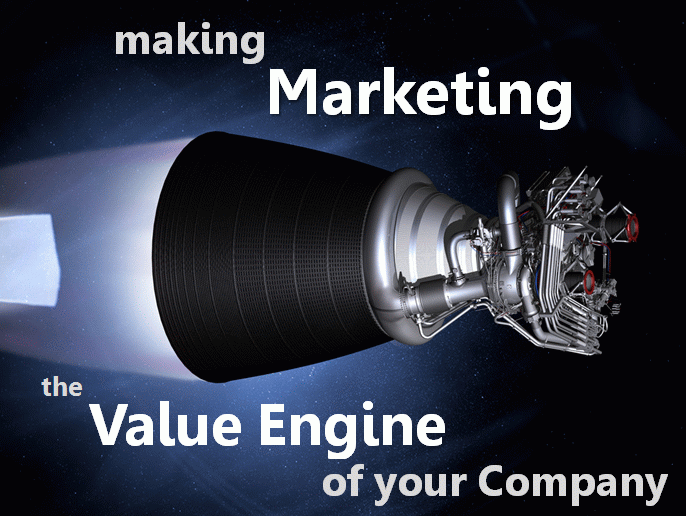This post originally appeared as a guest contribution in the Blog for the Austin chapter fo the American Marketing Organization
Peter Drucker, the father of modern business thinking, said that only marketing an innovation create value – everything else is basically overhead. He also said that marketing is the distinguishing function of an organization. Quite an endorsement about the Marketing function – but also a great responsibility.
In contrast, many people consider marketing to be deceptive, superfluous and buzz-wordy. Unfortunately, some marketing is one or all three of these. Unfortunately, marketers rank right next to used car salesmen in terms of reputation and trust. Interesting dichotomy.
What other teams in your company think about the marketing department: is it creating value for the company or spending money on funny ads? Maybe more importantly, we should ask ourselves, was Drucker wrong?
A hundred years ago companies were successful because of the products they built. Their value was linked directly to their products. Then companies were successful building distribution channels and getting their products in as many markets as possible – this was the era of the railroad. Then products became ubiquitous and advertising was created to create preference for specific products.
The value engine of an organization has shifted away from the products it creates created to the marketing function around their products. Today very few products are unique. You can get almost anything built in China for very little money. What people pay for is not the intrinsic characteristics of the product, but the value that marketing has added.
Financially speaking, brand value is measured as the net present value of what customers are willing to pay for a brand above what they are willing to pay for a generic product of similar characteristics. The brand value of Coca Cola is over $40 billion dollars. Companies that sell services to businesses like IBM and Microsoft also have large brand values (in the billions), all created by marketing.
Aside from what accounting may say, let’s look at two ends of the spectrum: commodities and luxury items to understand how marketing can create value.
In the luxury category, we can study this example: customers are lining up to pay $300 or more for a Michael Kors bag made of plastic. We are not talking Napa leather from sheep that are fed a strict diet and massaged every day. No, we are talking cheap, PVC plastic. Arguably, you can get the same quality bag for a fraction of the price at a discount store.
The value is not in the materials, so it must be in the design, right? The monogram ‘MK’ appears in gold letters in a pattern over brown, a pattern that is the same as used by many other designers from Gucci, Fendi, and other designers all the way down to much more affordable brands that also sell for a fraction of the cost. If the pattern is the same, it can’t be the design that creates the value.
The value is in the brand. Marketing has created something unique customers are willing to pay for: the perception of value. What is unique about these bags is not the design and is not the materials of which it is made for. The value is in how the bag makes women feel: fashionable, trendy, worthy of status, and members of a community that is identified by the brand mark.
You could say it is easy to understand how brands create value in luxury items. So let’s look at commodities: There is no bigger commodity than water. It covers over 70% of our planet and literally falls from the sky. It’s free. It’s simple in its composition (H2O). And it was $5.99 for a small bottle at the hotel I stayed a couple weeks back. Yep, more expensive than gasoline.
Why do we pay so much for something that is free? After all, water is water. We are willing to pay $5.99 because of the perceived value in purity, health (compared to the water I could get free from the faucet) and because of the market value of convenience and place (compared to getting the same bottle at a fourth of the price in the convenience store a block away).
Let’s look at one of the world’s true ‘commodities’ as defined by the financial markets: coffee. The price paid to a coffee grower in Colombia hovers around $0.86 dollars per pound.
Yet, the same pound of coffee direct from the Colombian Coffee Growers Federation (through their Juan Valdez brand) sells for $17. That is a $16 markup from the price paid to the grower – a 1600% markup because of marketing and distribution.
Now consider a cup of coffee at a local diner at $1. That’s about $40 per pound of coffee. And last, at Starbucks, where we happily pay $3 for a cup of coffee – or close to $100 per pound (and we still have to wait in line).
At Starbucks we are paying $100 for a product that costs less than a dollar. The $3 we pay are not for the value of the product itself. We pay for the value that marketing has created. The value Starbucks has created is in the brand, in the experience of getting a ‘Venti Espresso’ from a ‘Barista’; from the mood created by pastel colors, indirect lighting and modern décor; from the music playing in the background.
All these contribute to a brand experience that tricks our mind into believing the coffee is actually better. And we pay $3 for the experience because we deserve a little treat as we get ready for a day of hard work. It’s the emotions that we pay for, not the intrinsic quality of the coffee beans.
Marketing creates value by understanding customers and markets, guiding product design with customer requirements, communicating value effectively, educating customers, easing access to products, creating preference and generating demand. As Peter Drucker wrote, Marketing is the distinguishing function of the business.
The question then is: how are you creating value for your company?

